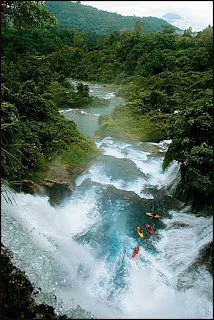
 The large wetland areas surrounding the Sepik and Fly rivers.This terrain has made it difficult for the country to develop transportation infrastructure. In some areas, airplanes are the only mode of transport Looking at a map of Island of Papua New Guinea , among many interesting items to be seen, is a river. The fly river , curious name, but not hard to believe for this part of the world As it turns out , it is named "Fly" for a different reason. The Fly is a major river of the island. It flows through Papua New Guinea almost entirely except for a short stretch where it forms part of the border with Indonesia's Iryan Jaya.That shows up as that little bend along the normally straight north south boundary.The fly originates in high in the central mountains, in the Victor Emanuel Range, which was produced by folding and thrust faulting alongthe northern edge of the Australian plate. The Fly is the world's 23 largest river. There is little economic activity save for a few coconut plantations and crocodiles hunt.On the Oktedi and Strickland , tributaries of the fly, are copper and gold mining operations .The Fly was not named for a pesky insect-- it was named for a ship Crocodile Farming in Papua New Guinea :
The large wetland areas surrounding the Sepik and Fly rivers.This terrain has made it difficult for the country to develop transportation infrastructure. In some areas, airplanes are the only mode of transport Looking at a map of Island of Papua New Guinea , among many interesting items to be seen, is a river. The fly river , curious name, but not hard to believe for this part of the world As it turns out , it is named "Fly" for a different reason. The Fly is a major river of the island. It flows through Papua New Guinea almost entirely except for a short stretch where it forms part of the border with Indonesia's Iryan Jaya.That shows up as that little bend along the normally straight north south boundary.The fly originates in high in the central mountains, in the Victor Emanuel Range, which was produced by folding and thrust faulting alongthe northern edge of the Australian plate. The Fly is the world's 23 largest river. There is little economic activity save for a few coconut plantations and crocodiles hunt.On the Oktedi and Strickland , tributaries of the fly, are copper and gold mining operations .The Fly was not named for a pesky insect-- it was named for a ship Crocodile Farming in Papua New Guinea : Hunting was a major occupation and was unrestricted.Some Australians and Europeans made fortunes by shooting thousands of crocodiles a year to make shoes and hand bags in Europe and North America. The Sepik region is an immense grassland reserve, surrounded by one of the World's greatest rivers which runs 1,126 kms from the origin in the mountains to the sea.The people along the river depend heavily on it for transportation , water and food.Their national links with the Sepik River are symbolized in many of their ancient and spiritual rituals, such as the manhood initiation.This requires painful carving of flesh on the backs of young men with razor blades.Patterns are that of a crocodile lying on the banks of the river.




